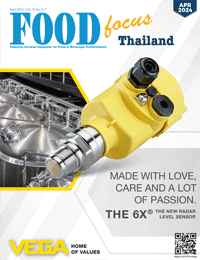การประยุกต์ใช้เทคโนโลยีขั้นสูงเพื่อดัดแปรแป้งที่มีค่าดัชนีน้ำตาลต่ำ Application of Advanced Starch-Modification Technology to Produce Low GI Starch
1681 Views |

การประยุกต์ใช้เทคโนโลยีขั้นสูงเพื่อดัดแปรแป้งที่มีค่าดัชนีน้ำตาลต่ำ
Application of Advanced Starch-Modification Technology to Produce Low GI Starch
By: ผศ.ดร. กรรณิการ์ กุลยะณี
Assist.Prof. Kannika Kunyanee, Ph.D.
School of Food Industry
King Mongkut’s Institute of Technology Ladkrabang
Kannika.ku@kmitl.ac.th
แป้งดัดแปร (Modified Flour) เริ่มเข้ามามีบทบาทสำคัญในการนำมาใช้ทดแทนแป้งธรรมชาติ (Native Flour) เพื่อให้ผลิตภัณฑ์อาหารนั้นๆ มีค่าดัชนีน้ำตาลที่ต่ำลง ซึ่งกระบวนการดัดแปรที่ใช้ในปัจจุบันมีหลากหลายวิธี ได้แก่ วิธีทางเคมี (Chemical Modification) วิธีทางชีววิทยา (Biochemical Modification) และวิธีทางกายภาพ (Physical Modification) ในขณะเดียวกัน การดัดแปรแป้งก็ยังช่วยปรับปรุงคุณสมบัติทางเคมีกายภาพ ซึ่งการเปลี่ยนคุณสมบัติเหล่านี้ยังมีผลต่อการเพิ่มขึ้นของสตาร์ชทนการย่อย (Resistant Starch) อีกด้วย
นวัตกรรมการผลิตแป้งด้วยวิธีดัดแปรทางกายภาพ (Novel Physical Technology)
ในปัจจุบันมีการนำเทคนิคการใช้คลื่นอัลตราซาวนด์ (Ultrasound Treatment) มาประยุกต์ใช้ในงานวิจัยเพื่อการดัดแปรแป้งหรือโมเลกุลของสตาร์ช ซึ่งเทคโนโลยีนี้มีข้อดีหลายประการ เช่น สามารถหลีกเลี่ยงการใช้สารเคมีได้ ช่วยลดระยะเวลาในการผลิต และมีความเป็นมิตรต่อสิ่งแวดล้อม การใช้คลื่นอัลตราซาวนด์ในการดัดแปรแป้งนั้นนอกจากจะทำให้คุณสมบัติบางประการของสตาร์ชเปลี่ยนแปลงไป เช่น คุณสมบัติด้านความหนืด (Pasting Properties) คุณสมบัติทางความร้อน (Thermal Properties) รวมถึงคุณสมบัติในการพองตัวและการละลาย (Swelling and Solubility) การใช้คลื่นอัลตราซาวนด์ยังมีผลในการปรับโครงสร้างของสตาร์ชทำให้เกิดการสร้างโมเลกุลของสตาร์ชทนการย่อยเพิ่มขึ้นอีกด้วย
ทั้งนี้ ยังมีกระบวนการดัดแปรด้วยวิธีการใช้ความร้อนร่วมกับความชื้น (Heat-moisture Treatment; HMT) และวิธีแอนนิลลิ่ง (Annealing Treatment; ANN) ที่จะทำให้ได้สตาร์ชที่มีคุณสมบัติทางเคมีกายภาพและคุณสมบัติด้านการย่อยที่เปลี่ยนแปลงไป โดยจะขึ้นอยู่กับชนิดของสตาร์ชและสภาวะที่ใช้ในการดัดแปร นอกจากนี้ยังมีการนำเทคโนโลยีคลื่นอัลตราซาวนด์มาใช้ร่วมกับวิธีการใช้ความร้อนร่วมกับความชื้น (Ultrasound + HMT) และการใช้คลื่นอัลตราซาวนด์ร่วมกับวิธีแอนนิลลิ่ง (Ultrasound + ANN) ซึ่งพบว่าการใช้สองวิธีร่วมกันเช่นนี้มีบทบาทสำคัญอย่างยิ่งในการปรับเปลี่ยนคุณสมบัติของแป้ง และช่วยเพิ่มปริมาณของสตาร์ชทนการย่อย (Resistant Starch) ได้เช่นกัน โดยการใช้คลื่นอัลตราซาวนด์ในช่วงแรกของกระบวนการนั้นจะส่งผลให้บริเวณส่วนผลึกภายในโครงสร้างของสตาร์ชเกิดการเปลี่ยนแปลง หากใช้ความเข้มของคลื่นอัลตราซาวนด์ที่สูงขึ้นก็จะยิ่งส่งผลถึงสัดส่วนของอะไมโลส (Amylose) และอะไมโลเพกติน (Amylopectin) โดยเฉพาะปริมาณอะไมโลสที่จะเพิ่มขึ้น ทั้งนี้การเปลี่ยนแปลงดังกล่าวจะขึ้นอยู่กับความเข้มของคลื่นอัลตราซาวนด์ กำลังวัตต์ ชนิดของสตาร์ช และสัดส่วนของอะไมโลสต่ออะไมโลเพกติน เป็นต้น นอกจากนี้ การใช้คลื่นอัลตราซาวนด์ร่วมกับ HMT หรือ ANN ยังส่งผลถึงโครงสร้างผลึกของแป้ง เนื่องจากจะช่วยทำให้การจัดเรียงตัวโครงสร้างเกลียวคู่มีความเป็นระเบียบมากขึ้นอีกด้วย
Modified flour has gained a more significant role in replacing native flour as a solution to reduce the glycemic index in food. Several starch modification methods are currently available: chemical, biochemical, and physical modification. These techniques can enhance the chemical and physical properties of flour, thus contributing to an increase in resistant starch as well.
Novel Physical Technology for Flour Modification
Ultrasound treatment is currently used in research to modify flour or starch molecules. This technology has several advantages: it reduces chemical dependency, shortens production time, and is environmentally friendly. The ultrasound treatment not only alters certain starch properties, such as pasting properties, thermal properties, swelling, and solubility, but it also induces structural modifications and generates more molecules that contribute to resistant starch.
Other modification methods include heat-moisture treatment (HMT) and annealing treatment (ANN), both of which can alter chemical and digestion properties depending on the starch type and treatment condition. Additionally, ultrasound can be co-implemented with these two treatments (Ultrasound + HMT or Ultrasound + ANN), which can significantly modify starch properties and trigger an increase in resistant starch. The ultrasonic irradiation, when applied in the early stages of treatment, can modify the crystalline portion of the starch structure. With higher intensity, it can reach and alter amylose and amylopectin, thus elevating their levels. Modification results may vary as they depend on, for instance, ultrasonic intensity, watt, starch type, and ratio of amylose and amylopectin. Moreover, Ultrasound-HMT or ultrasound-ANN can affect the crystalline structure of starch as these techniques restructure double helix formations.






